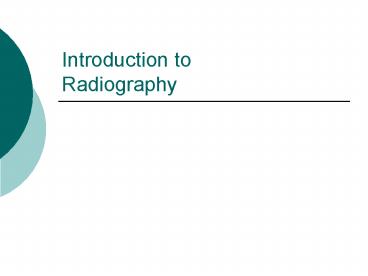Introduction to Radiography - PowerPoint PPT Presentation
1 / 24
Title:
Introduction to Radiography
Description:
Radiography ... History of Radiography ... Diagnostic services. Radiology. Medical technologist. Clinical laboratory. Electroencephalography ... – PowerPoint PPT presentation
Number of Views:3276
Avg rating:3.0/5.0
Title: Introduction to Radiography
1
Introduction to Radiography
2
Radiation
- Energy that is transmitted by waves through space
or a medium
3
Energy
- The capacity to operate or work
- Higher forms of energy like x-rays have the
ability to ionize atoms in matter.
4
Ionization
- Any process by which a neutral atom gains or
loses an electron thus acquiring a net charge.
5
Types of Energy
- Mechanical energy
- The ability to do work due to motion or location
- Thermal energy
- Transmittance of heat
- Nuclear energy
- Energy emitted by the nucleus of an atom
- Electromagnetic energy
- The man made form is x-rays
6
Radiography
- The making of film records known as radiographs
of internal structures of the body by passage of
x-rays through the body to act on specially
sensitized film.
7
History of Radiography
- November 8, 1895 is the recognized day of the
discovery of x-rays by Wilhelm Conrad Roentgen, a
German physicist.
8
Cathode
- Contains a filament which emits electrons when
heated. - Considered the negative side of the tube.
9
Anode
- A cold metallic palte on the other side of the
tube. - Considered the positive side of the tube.
10
Radiologic technology
- Technical science that deals with the use of
x-rays or radioactive substances for diagnostic
or therapeutic purposes in medicine.
11
Radiologic Technologist (RT)
- Individuals qualified to use radiation to produce
images of the internal parts of the body for
interpretation - Also called radiographers
- Our title R.T. (R) means registered technologist
(radiography)
12
American Registry of Radiologic Technologist
(ARRT)
- The governing board which administers the
registry examination for all RTs
13
Radiologist
- A physician that interprets radiographic images
14
Specialties in Radiography
- Cardiovascular Interventional Technology
(CVIT)(VIT) - Angiography -Radiologic examination of the blood
vessels after injection of contrast medium - Cardiac catherization placing a catheter in one
of the chambers of the heart and coronary
arteries - Angioplasty treatment of blocked blood vessels
without the need for invasive surgery
15
Specialties in Radiography
- Mammography
- Radiographic examination of the breast
16
Specialties in Radiography
- Computed Tomography (CT)
- A specialized form of radiography which utilizes
special equipment for imaging the body in various
planes
17
Specialties in Radiography
- Nuclear Medicine Technology (NMT)
- Involves imaging parts of the patient after the
introduction of a radioactive material known as a
radio pharmaceutical either orally or
intravenously.
18
Specialties in Radiography
- Magnetic Resonance Imaging
- Uses a strong magnetic field and raio waves along
with a computer to generate sectional images of
the patients anatomy
19
Specialties in Radiography
- Radiation Therapy
- Administration of high energy ionizing radiation
to treat primarily malignant tumors (cancers) - Radiation therapist
- Technologist
- Radiation oncologist
- Physician
20
Specialties in Radiography
- Sonography
- Visualization of structures of the body by
recording ultrasound waves directed into tissue - Sonographer
- Technologist
21
Additional Opportunities for RTs
- Education
- Clinical instructor
- Clinical coordinator
- Program coordinator
- Instructor / faculty member
22
Additional Opportunities for RTs
- Administration
- Supervisors
- Chief technologists
- Managers
- Department heads
23
Additional Opportunities for RTs
- Commercial firms
- Sales
- Equipment maintenance
- Technical support personnel
- Consultants
24
The Health Care Team
- Doctors
- Nurses
- Therapist
- Health information services
- Diagnostic services
- Radiology
- Medical technologist
- Clinical laboratory
- Electroencephalography































